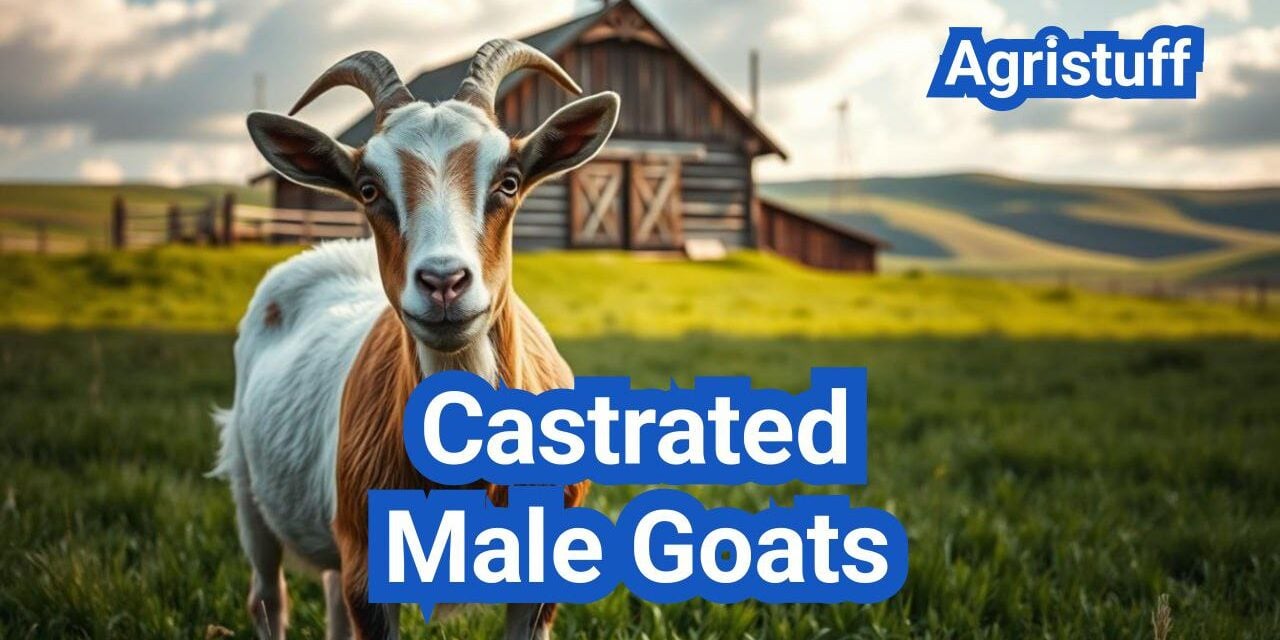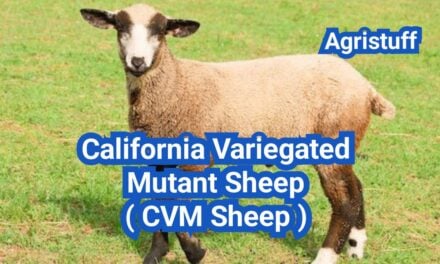A wether goat is a domesticated goat that has been castrated before reaching sexual maturity. This practice is common in goat farming to manage behavior and improve meat quality.
Castration involves removing the testicles, which reduces testosterone production, affecting the goat’s temperament and physical development. As a result, wether goats are generally more docile and easier to handle than intact males.
The benefits of castrating male goats include improved behavior and enhanced meat quality, making it a valuable practice in goat management.
Key Takeaways
- Castration reduces testosterone production, making goats more docile.
- Wether goats are easier to handle and manage.
- Castration improves meat quality.
- The practice is common in goat farming.
- Wether goats have different temperament and physical development.
Understanding Wethers: Defining the Castrated Male Goat
In the context of goat husbandry, understanding the distinction between a wether and other male goats is crucial. A wether is a castrated male goat, a term that is often misunderstood or confused with other terminology related to male goats and sheep.
What Exactly is a Wether?
A wether is defined as a male goat that has been castrated, typically at a young age. This process involves removing or destroying the testicles to prevent breeding and reduce aggression. As Dr. Susan Schoenian, a goat expert, notes, “Castration is a common practice in goat farming to make male goats more manageable and improve their meat quality.”
“Castration is a management tool that can improve the overall quality of life for both the animal and the farmer.”
Wether vs. Buck: Key Differences
The primary difference between a wether and a buck (an intact male goat) lies in their reproductive status and behavior. Bucks are known for their strong odor and aggressive behavior, especially during breeding season. In contrast, wethers are generally more docile and are often preferred for meat production due to their improved temperament and reduced ‘buck smell’.
- Wethers are castrated male goats, while bucks are intact.
- Wethers are typically more docile than bucks.
- The meat of wethers is considered more palatable due to the absence of ‘buck smell’.
Distinguishing Between Castrated Male Goats and Sheep
While both goats and sheep are raised for meat, their classification and characteristics differ. A castrated male goat is called a wether, whereas a castrated male sheep is referred to as a wether or sometimes a ‘wether sheep’. The key differences lie in their physical characteristics, behavior, and the purposes for which they are raised.
Understanding these distinctions is vital for farmers and consumers alike to appreciate the unique qualities of each animal. As the demand for goat meat continues to grow, clarifying the terminology surrounding castrated male goats becomes increasingly important.
Why Castrate Male Goats? Benefits for Small Farms

Castrating male goats, or wethers, offers several advantages for small farm management. This practice is particularly beneficial for controlling breeding, managing behavior, improving meat quality, and considering economic factors.
Preventing Unwanted Breeding
One of the primary reasons for castrating male goats is to prevent unwanted breeding. This is especially important on small farms where maintaining a controlled breeding program is crucial for managing the herd’s size and genetics.
- Prevents unexpected births
- Allows for a controlled breeding program
- Helps in maintaining a desired herd size
Behavior Management Benefits
Castration significantly impacts the behavior of male goats, making them less aggressive and easier to handle. Intact males can become aggressive as they mature, posing a risk to other animals and humans.
Key behavioral changes post-castration include:
- Reduced aggression
- Less dominance behavior
- Easier handling and management
Meat Quality Improvements
Castrating male goats can improve the quality of their meat by reducing the strong, unpleasant flavors associated with intact males. This makes the meat more marketable and desirable to consumers.
Meat quality improvements include:
- Tender meat
- Less “bucky” flavor
- Better overall palatability
Economic Considerations for Small Farms
While castration has several benefits, it’s also important to consider the economic implications. The cost of castration, potential veterinary care, and the impact on the farm’s overall productivity are factors to be considered.
Economic benefits may include:
- Increased market value for wether meat
- Reduced costs associated with managing aggressive males
- Improved overall farm efficiency
When to Castrate: Age Considerations for Goat Kids
Castrating goat kids at the right age is essential for managing their behavior and improving meat quality. The decision on when to castrate depends on several factors, including the breed of the goat, farm conditions, and the method of castration to be used.
Optimal Age Windows for Castration
The ideal age for castrating goat kids is generally considered to be between 2 to 8 weeks. Castrating within this age range helps minimize stress and complications. It’s also a period when the kids are still young enough that the procedure is less traumatic.
Early vs. Late Castration Pros and Cons
Early castration, typically done before the kids reach 2 weeks of age, can reduce the risk of unwanted breeding and aggressive behavior associated with intact males. However, it may also increase the risk of certain health issues if not done properly.
Late castration, after 8 weeks, may allow for better development of certain physical characteristics but can also lead to more pronounced male behavior and potentially more challenging castration procedures.
Seasonal Timing Factors
The timing of castration can also be influenced by seasonal factors. For instance, castrating kids during periods of extreme weather or when the farm is busiest with other tasks might not be ideal. Farmers should consider the overall management schedule and environmental conditions when planning castration.
Additionally, seasonal factors can impact the risk of infection and the overall stress levels of the animals. For example, castrating during hot and humid weather may increase the risk of infection, while castrating during colder months might reduce this risk but could increase stress due to cold stress.
Preparing for Castration: Tools and Supplies

To ensure a smooth castration process, farmers must prepare the right equipment and conditions. Proper preparation is crucial for the health and safety of both the animal and the person performing the castration.
Essential Equipment Checklist
Having the right tools is vital for a successful castration. The essential equipment includes:
- Castration bands or rings
- Elastrator tool
- Burdizzo clamp
- Surgical instruments (if performing surgical castration)
- Gloves
- Antiseptic solution
| Equipment | Purpose |
|---|---|
| Castration bands or rings | Used for banding method to cut off blood flow |
| Elastrator tool | Applies bands or rings to the goat kid |
| Burdizzo clamp | Crushes the spermatic cords without cutting the skin |
| Surgical instruments | Used for surgical castration, requiring precision and sterility |
Medication and Pain Management Options
Pain management is a critical aspect of castration. Options include:
- Local anesthesia
- Non-steroidal anti-inflammatory drugs (NSAIDs)
Consulting with a veterinarian to determine the best pain management strategy is recommended.
Creating a Clean Working Environment
A clean environment minimizes the risk of infection. Ensure that:
- The working area is clean and disinfected
- All equipment is sterilized before use
Restraint Methods for Kid Safety
Safe restraint is crucial to prevent injury to both the handler and the goat kid. Methods include:
- Using a restraint table or cradle
- Having an assistant hold the kid securely
By carefully preparing the necessary tools, managing pain effectively, maintaining a clean environment, and using appropriate restraint methods, farmers can ensure a safe and humane castration process for their goat kids.
Banding: The Elastrator Method for Castrated Male Goats
For many farmers, the elastrator method is the preferred choice for castrating male goats. This technique involves using a rubber band to constrict the blood flow to the testicles, effectively castrating the animal. The elastrator method is known for its simplicity and effectiveness when performed correctly.
Step-by-Step Banding Procedure
The banding procedure requires some specific tools and a careful approach to ensure the process is as painless as possible for the animal. Here’s a step-by-step guide:
- Restrain the goat kid securely to prevent movement during the procedure.
- Clean the scrotum and surrounding area to minimize the risk of infection.
- Use an elastrator tool to place a rubber ring around the scrotum, above the testicles.
- Ensure the ring is tight and the testicles are below the ring.
- Release the goat kid and monitor for any signs of complications.
Pros and Cons of Rubber Band Castration
The elastrator method has both advantages and disadvantages that farmers should consider:
| Advantages | Disadvantages |
|---|---|
| Simple and quick to perform | Risk of tetanus infection if not done hygienically |
| Minimally invasive | Potential for prolonged pain if the band is not applied correctly |
| Low cost compared to surgical methods | Risk of complications if the band slips or is improperly applied |
Tetanus Prevention for Banded Goats
One of the significant risks associated with the elastrator method is tetanus infection. To mitigate this risk, farmers can take several precautions:
- Ensure the elastrator tool and rubber rings are clean and sterilized before use.
- Administer tetanus antitoxin or ensure the goat is properly vaccinated against tetanus.
- Monitor the goat for signs of tetanus infection after the procedure.
By following these guidelines and taking necessary precautions, farmers can effectively use the elastrator method for castrating male goats, minimizing risks and ensuring the health and well-being of their animals.
Burdizzo Castration: The Bloodless Clamp Method
The Burdizzo clamp method is a bloodless castration technique that has gained popularity for its minimal infection risk. This method involves using a Burdizzo clamp to crush the spermatic cords without breaking the skin, thus preventing testicular function.
Step-by-Step Burdizzo Procedure
To perform Burdizzo castration effectively, follow these steps:
- Restrain the goat kid securely to prevent movement.
- Locate the spermatic cords and position the Burdizzo clamp accordingly.
- Crush the spermatic cords using the Burdizzo clamp, ensuring that the testicular function is halted.
- Repeat the process for the other testicle, taking care not to clamp too close to the body.
Advantages and Disadvantages of Burdizzo Method
The Burdizzo method offers several advantages, including reduced risk of infection due to the absence of open wounds and minimal bleeding. However, it requires skill to perform correctly, and there’s a risk of incomplete castration if not done properly.
| Advantages | Disadvantages |
|---|---|
| Minimal infection risk | Requires skill and experience |
| No open wounds | Risk of incomplete castration |
| Less stressful for the animal compared to surgery | Limited to early age castration |
Equipment Selection and Maintenance
Selecting the right Burdizzo clamp is crucial for effective castration. The clamp should be appropriate for the size of the goat kid, and its jaws should be in good condition to ensure a clean crush.
- Choose a Burdizzo clamp that fits the size and age of the goat kid.
- Regularly inspect and maintain the clamp to ensure it remains in good working condition.
- Clean the clamp after each use to prevent the spread of disease.
By following these guidelines and using the Burdizzo method correctly, farmers can effectively castrate male goats while minimizing the risk of complications.
Surgical Castration: When and How to Use This Method
While less common than banding or Burdizzo methods, surgical castration remains a viable option under specific circumstances. This method involves physically removing the testicles through a surgical incision. It is typically considered for older kids or when other castration methods are not suitable.
Preparation for Surgical Castration
Proper preparation is crucial for a successful surgical castration. This includes having the necessary equipment, such as a scalpel, forceps, and sutures, as well as ensuring a clean and safe working environment. The kid should be restrained appropriately to minimize stress and prevent injury during the procedure.
Pre-operative care also involves assessing the overall health of the kid to identify any potential risks. It is advisable to consult with a veterinarian, especially if you are inexperienced with surgical castration.
Step-by-Step Surgical Procedure
The surgical castration procedure involves several key steps:
- Restrain the kid securely to prevent movement.
- Clean and disinfect the scrotal area.
- Make a small incision in the scrotum to expose the testicles.
- Remove the testicles and ligate the spermatic cord.
- Close the incision with sutures if necessary.
It’s critical to maintain asepsis throughout the procedure to minimize the risk of infection. Post-operative care instructions should be followed diligently to ensure proper healing.
When to Seek Veterinary Assistance
While experienced farmers may perform surgical castration, there are situations where seeking veterinary assistance is advisable. This includes cases where the kid is older or larger, or if there are complications during the procedure.
A veterinarian can provide guidance on pain management and post-operative care, enhancing the kid’s recovery experience.
Recovery Expectations After Surgery
After surgical castration, monitoring the kid for signs of infection or complications is essential. The recovery period typically involves keeping the kid in a clean, dry environment and observing for any abnormal behavior.
Most kids recover within a few weeks, but it’s crucial to follow a post-operative care plan that includes monitoring for infection and managing pain effectively.
Post-Castration Care: Ensuring Proper Healing
After castration, goat kids require careful attention to ensure they heal properly. The post-castration period is critical for preventing complications and promoting overall health.
Immediate Aftercare Protocols
Immediately after castration, it’s essential to monitor the goat kid closely. Keep the environment clean and dry to prevent infection. Ensure the goat has access to fresh water and is in a safe, stress-free environment.
Key aftercare steps include:
- Monitoring the castration site for signs of infection or swelling
- Keeping the area clean to prevent the introduction of bacteria
- Providing adequate nutrition and hydration
- Minimizing stress through a calm environment
Monitoring for Complications
Complications can arise after castration, including infection, excessive swelling, or tetanus. Regular monitoring is crucial to identify any issues early.
| Complication | Signs to Look For | Action to Take |
|---|---|---|
| Infection | Redness, swelling, discharge, or a foul odor from the castration site | Consult a veterinarian for antibiotics or further treatment |
| Tetanus | Muscle stiffness, difficulty walking, or convulsions | Seek immediate veterinary care |
Pain Management Strategies
Managing pain is an essential aspect of post-castration care. Options include:
- Administering pain relief medication as advised by a veterinarian
- Using non-pharmacological methods such as providing a comfortable environment
“Pain management is crucial for the welfare of the animal and can impact the recovery process.” – Veterinary Expert
Return to Normal Activity Timeline
The timeline for returning to normal activities varies depending on the castration method and the individual goat’s health. Generally, most goats can return to normal within a few days to a week.
Guidelines for Return to Normal Activity:
- Monitor the goat’s behavior and health closely
- Gradually introduce normal activities to prevent stress
- Ensure the castration site is healing properly before resuming full activity
Health Concerns: Managing Urinary Calculi in Wethers

Urinary calculi pose a serious health risk to wethers, necessitating a comprehensive approach to prevention that includes diet management and supplementation. This condition, commonly referred to as “waterbelly,” can lead to significant discomfort and even death if not properly managed.
Understanding Waterbelly in Castrated Male Goats
Waterbelly, or urinary calculi, occurs when mineral deposits form in the urinary tract of wethers, potentially causing blockages. This condition is particularly problematic in castrated male goats due to their narrower urethra compared to intact males.
The formation of urinary calculi is often linked to dietary factors, including an improper calcium to phosphorus ratio and inadequate water intake. Ensuring that wethers have access to plenty of clean water and a balanced diet is crucial in preventing this condition.
Calcium to Phosphorus Ratio Management
Managing the calcium to phosphorus ratio in the diet is critical for preventing urinary calculi. An ideal ratio helps prevent the formation of stones. Farmers should ensure that the feed provided to wethers maintains a proper balance of these minerals.
A diet with an improper calcium to phosphorus ratio can lead to the formation of urinary calculi. For instance, a diet too high in phosphorus can increase the risk of stone formation.
Ammonium Chloride Supplementation
Ammonium chloride supplementation is a strategy used to prevent urinary calculi. It works by acidifying the urine, making it less likely for minerals to precipitate out and form stones.
However, the use of ammonium chloride should be carefully managed, as excessive supplementation can lead to other health issues. It’s essential to consult with a veterinarian to determine the appropriate dosage.
Water and Diet Considerations for Prevention
Adequate water intake is essential for preventing urinary calculi. Wethers should have access to clean, fresh water at all times to help flush out minerals that could form stones.
Dietary adjustments, such as providing a balanced feed and ensuring the right calcium to phosphorus ratio, are also vital. Regular monitoring of the wethers’ health and adjustments to their diet as needed can help prevent urinary calculi.
By understanding the risks associated with urinary calculi and implementing preventive measures, farmers can significantly improve the health and well-being of their wethers.
Nutrition Management for Healthy Wethers

The dietary needs of wethers change after castration, requiring adjustments in their nutrition management. Proper nutrition is vital for ensuring the health, growth, and productivity of wethers.
Dietary Requirements After Castration
After castration, wethers have different nutritional needs compared to intact males. Their energy requirements may decrease, while their need for certain minerals may increase. It’s essential to adjust their diet accordingly to prevent nutritional deficiencies or excesses.
Key Nutritional Considerations:
- Energy intake: Wethers may require less energy due to reduced activity and aggression.
- Protein intake: Adequate protein is necessary for growth and maintenance.
- Mineral balance: Certain minerals like calcium and phosphorus are crucial for bone health.
Feed Formulation for Growth and Health
Formulating the right feed for wethers involves balancing their nutritional needs. A well-balanced diet should support their growth, health, and productivity.
Feed Formulation Tips:
- Use high-quality hay and grains as the base of their diet.
- Consider adding supplements to address specific nutritional needs.
- Ensure access to clean water at all times.
Mineral Supplementation Strategies
Mineral supplementation is critical for maintaining the health of wethers. Certain minerals play a crucial role in preventing health issues.
| Mineral | Importance | Supplementation Strategy |
|---|---|---|
| Calcium | Bone health | Provide calcium-rich feed or supplements. |
| Phosphorus | Bone health, energy metabolism | Ensure adequate phosphorus intake through feed or supplements. |
| Magnesium | Muscle and nerve function | Include magnesium-rich feed or supplements in the diet. |
Seasonal Feeding Adjustments | Castrated Male Goats
Seasonal changes can impact the nutritional needs of wethers. Adjusting their diet according to the season can help maintain their health and productivity.
Seasonal Considerations:
- Winter: Increase energy intake to compensate for colder temperatures.
- Summer: Ensure adequate hydration and consider heat stress mitigation strategies.
Pasture Management for Meat Wethers

To maximize the health and productivity of meat wethers, farmers must implement sound pasture management practices. Effective pasture management is crucial for ensuring the well-being of castrated male goats raised for meat.
Rotational Grazing Systems | Castrated Male Goats
Rotational grazing is a key component of successful pasture management. By dividing pastures into smaller sections and rotating the wethers through them, farmers can prevent overgrazing and allow for adequate forage regrowth. This approach not only improves pasture productivity but also enhances biodiversity and reduces the risk of parasite buildup.
Benefits of Rotational Grazing:
- Increased forage utilization
- Improved soil health
- Enhanced biodiversity
- Reduced parasite loads
Parasite Management Using FAMACHA Scoring
Parasite control is a critical aspect of pasture management for meat wethers. The FAMACHA scoring system is a valuable tool for assessing the level of parasitic infection in goats. By regularly checking the color of the animal’s conjunctiva, farmers can identify those that are anemic due to parasite infestation and treat them accordingly.
“FAMACHA scoring allows farmers to target treatment to those animals that need it most, reducing the overall use of anthelmintics and slowing the development of resistance.”
Forage Selection for Optimal Growth
Selecting the right forage is essential for promoting optimal growth and health in meat wethers. Farmers should choose forages that are high in nutritional value and suitable for the local climate and soil conditions. Legumes, grasses, and browse plants can be used in various combinations to create a diverse and nutritious diet.
Stocking Density Considerations | Castrated Male Goats
Stocking density, or the number of animals per unit of pasture area, significantly impacts pasture health and productivity. Overstocking can lead to overgrazing and degradation of the pasture, while understocking may result in underutilization of available forage. Farmers must carefully manage stocking density to balance animal needs with pasture capacity.
“Proper stocking density is key to maintaining a healthy and productive pasture. It requires careful planning and monitoring to ensure that the pasture can support the number of animals grazing on it.”
By implementing these pasture management strategies, farmers can improve the health, productivity, and overall well-being of their meat wethers.
Behavior Management: Working with Castrated Male Goats

The process of castration brings about notable behavioral changes in male goats, which are crucial for farmers to understand for better herd management. Castration leads to reduced aggression and sexual behavior, making wethers generally easier to manage.
Expected Behavioral Changes Post-Castration
After castration, male goats typically exhibit a decrease in aggressive behavior. This reduction in aggression makes wethers less likely to fight, resulting in fewer injuries within the herd. Additionally, castration eliminates sexual behavior, which can simplify the management of mixed-sex herds.
Key behavioral changes include:
- Reduced aggression towards other goats
- Elimination of sexual behavior
- Potential changes in social dynamics within the herd
Training and Handling Techniques | Castrated Male Goats
Training and handling wethers require patience and consistency. Since wethers are generally less aggressive and more docile than intact bucks, they can be easier to train. Positive reinforcement techniques, such as offering treats, can be effective in training wethers to follow commands and behave appropriately.
Effective training tips:
- Use positive reinforcement techniques
- Be consistent in training and handling
- Start training early to establish good behavior
Integration with the Herd | Castrated Male Goats
Integrating wethers into the herd can be relatively straightforward due to their reduced aggression. However, it’s essential to monitor the herd dynamics, especially when introducing new wethers to intact does or bucks. A gradual introduction, allowing the goats to become familiar with each other’s scents and presence, can help prevent conflicts.
“Introducing new animals to the herd should be done gradually to prevent stress and conflict.”
Comparison to Buck Behavior | Castrated Male Goats
Wethers behave differently than intact bucks, primarily due to the reduction in testosterone levels post-castration. Bucks are known for their aggressive behavior during mating season, which can include fighting and territorial marking. In contrast, wethers are more docile and less likely to engage in these behaviors, making them a more manageable option for many farmers.
The main differences between wethers and bucks include:
| Behavioral Trait | Wethers | Bucks |
|---|---|---|
| Aggression Level | Lower | Higher, especially during mating season |
| Sexual Behavior | Absent | Present, with mating behaviors |
Meat Quality in Wethers: Maximizing Value

The quality of meat from wethers is a crucial factor for producers aiming to maximize their returns. Castration significantly impacts the characteristics of the meat, making it a vital consideration for farmers.
Comparing Flavor Profiles | Castrated Male Goats
Wether meat is known for its milder flavor compared to intact bucks. The castration process reduces the strong, musky flavor associated with male goats, making wether meat more palatable to consumers. This difference in flavor profile is a significant advantage for producers looking to cater to a broader market.
Flavor Profile Comparison
- Wether meat: Mild, tender, and less gamey
- Intact buck meat: Strong, musky, and often considered less desirable
Eliminating “Buck Smell” | Castrated Male Goats
The “buck smell” or the strong odor associated with intact male goats, is a result of certain compounds in the meat. Castration significantly reduces these compounds, thereby eliminating the undesirable smell. Proper finishing techniques and dietary management also play a crucial role in ensuring the meat remains free from any off-flavors.
Optimal Slaughter Age and Weight | Castrated Male Goats
Determining the optimal slaughter age and weight is critical for maximizing the value of wether meat. Generally, wethers are slaughtered between 6 to 12 months of age, depending on breed, nutrition, and market requirements. Achieving the ideal weight, typically between 70 to 100 pounds, is also essential for producing high-quality meat.
Finishing Techniques for Premium Meat | Castrated Male Goats
Finishing techniques involve the final stages of feeding before slaughter, aimed at enhancing the quality and palatability of the meat. Strategies include providing high-quality feed, ensuring adequate nutrition, and managing stress levels. These practices contribute to producing premium wether meat that commands a higher market price.
Key Finishing Techniques:
- Provide a nutrient-rich diet to promote marbling and tenderness
- Ensure access to clean water and adequate living conditions
- Minimize stress through gentle handling and appropriate housing
By focusing on these aspects, producers can significantly enhance the quality and value of their wether meat, catering to consumer preferences and achieving better market returns.
Best Practices for Wether Management
Effective wether management is crucial for the well-being and productivity of castrated male goats. Proper castration techniques, nutritional management, health care, and behavior management are all essential components of a comprehensive care plan.
Castration is a critical step in managing male goats, and choosing the right method is vital. Whether using banding, Burdizzo, or surgical castration, it’s essential to follow best practices to minimize stress and prevent complications.
In addition to proper castration, wether management involves providing optimal nutrition, health care, and behavior management. A well-balanced diet that meets the nutritional needs of wethers is critical for growth and health. Regular health checks and parasite management are also vital to prevent disease.
By following best practices for wether management, farmers can improve the quality and value of their goat meat. Effective castration, nutrition, health care, and behavior management all contribute to producing high-quality wethers that meet market demands.
FAQ
What is a wether goat?
A wether goat is a castrated male goat. Castration is a common practice in goat management that involves removing the testicles to prevent breeding and improve behavior and meat quality.
Why castrate male goats?
Castrating male goats prevents unwanted breeding, aids in behavior management, improves meat quality, and has economic benefits for small farm owners.
What is the optimal age for castrating goat kids?
The optimal age for castrating goat kids varies, but it is generally recommended to castrate between a few days to a few weeks old. Early castration can help prevent unwanted breeding and reduce undesirable male behaviors.
What are the different methods of castrating goats?
The main methods of castrating goats are banding (using an elastrator), Burdizzo (a bloodless clamp method), and surgical castration. Each method has its advantages and disadvantages.
How do I prevent tetanus infection in banded goats?
To prevent tetanus infection in banded goats, ensure proper hygiene during the banding process, and consider administering a tetanus vaccination or booster to the kid before or at the time of banding.
What are the signs of infection after castration?
Signs of infection after castration include swelling, redness, discharge, or a foul odor from the castration site. Monitor the kid closely after castration and seek veterinary assistance if you suspect infection.
How can I manage urinary calculi in wethers?
Managing urinary calculi in wethers involves maintaining a proper dietary calcium to phosphorus ratio, supplementing with ammonium chloride, ensuring adequate water intake, and making dietary adjustments to prevent the condition.
What are the dietary requirements for wethers after castration?
After castration, wethers require a balanced diet that supports their growth and health. This includes providing high-quality feed, ensuring adequate mineral supplementation, and making seasonal adjustments as necessary.
How do I manage the behavior of wethers?
Managing the behavior of wethers involves understanding the expected behavioral changes post-castration, using proper training and handling techniques, and integrating them into the herd. Wethers generally exhibit less aggressive behavior than intact bucks.
How can I improve the meat quality of wethers?
Improving the meat quality of wethers involves selecting the optimal slaughter age and weight, using appropriate finishing techniques, and ensuring the elimination of “buck smell” through proper handling and feeding practices.
What is FAMACHA scoring, and how is it used in parasite management?
FAMACHA scoring is a method used to assess the level of anemia in goats due to parasite infestation. It involves evaluating the color of the conjunctiva to determine the need for deworming, thus aiding in parasite management.
What are the benefits of rotational grazing for meat wethers?
Rotational grazing offers several benefits for meat wethers, including improved forage utilization, reduced parasite loads, and enhanced overall health and productivity.
Conclusion of: Castrated Male Goats
Introduction: What a Wether Is and Why It Matters
A wether is simply a castrated male goat, and the term is used everywhere from homesteads to commercial meat operations. Understanding what a castrated male goat is helps you make better management decisions—because once testes are removed or inactivated, a young buck’s hormones, growth curve, and behavior all shift in predictable ways. In U.S. herds, wethers are common for three reasons: they’re easier to keep with does without accidental breeding, safer to handle, and often preferred for certain meat markets. Anyone raising goats for family milk, brush control, show projects, or chevon should know how a castrated male goat fits into the bigger herd plan. UC ANR meat-goat glossary and wether definition
Why Producers Choose to Raise a Castrated Male Goat
Farmers often turn buck kids into a castrated male goat to reduce unwanted pregnancies, simplify fencing needs, and lower the risk of fighting as males mature. Intact bucks can become hard on facilities and people during rut, and even small herds can be disrupted by constant mounting and odor. Wethers also make reliable companions for does, weanlings, or other wethers without creating breeding pressure. In most management systems, the calm, predictable nature of a castrated male goat makes daily chores—feeding, trimming hooves, moving pens—much safer and faster. U.S. extension guidance consistently notes that castration is a practical tool for herd control and day-to-day safety. Oklahoma State Extension—general wethering benefits
How Castration Changes the Body and Hormones
When you create a castrated male goat, you remove the main source of testosterone. That drop in hormones affects muscle-to-fat ratios, smell, and some secondary sexual traits like a thick neck and heavy scent glands. Testosterone also drives sexual behavior and aggression, so a castrated male goat typically transitions to calmer social patterns over time. The earlier the procedure is done, the more thoroughly hormone-driven traits are reduced before puberty, which is why early wethering is so common in small herds. Veterinary policy statements emphasize that castration alters physiology in ways that can improve manageability and sometimes meat quality, especially by reducing strong male odor. CVMA policy statement on castration effects and timing
Behavior: What to Expect From a Castrated Male Goat
Most owners notice behavior improvement after a buck becomes a castrated male goat. Wethers are less likely to challenge other goats, spray urine on themselves, or bully pen mates, and their odor is usually milder outside breeding season. That said, a castrated male goat can still play rough, especially in groups, so adequate space and enrichment matter. Handling is usually easier because wethers respond more like does or juveniles than like mature bucks, which is a big advantage for families or 4-H projects. Low-stress handling and consistent routines help a castrated male goat stay calm and productive. Understanding goat behavior and low-stress handling
Choosing the Right Age to Castrate
Timing is one of the biggest decisions in raising a castrated male goat. Very early castration (first few weeks) is easy to perform and limits aggressive development, but some evidence links very early castration to a narrower urethra, which can increase urinary stone risk later. Many U.S. producers choose a middle path: castrate after the kid is strong and bonded, but not so late that behavior becomes difficult. If your system relies on early grouping of kids, early castration can still work well as long as you manage diet carefully. Cornell’s goat program explains that age should balance convenience, welfare, and urinary health in any castrated male goat plan. Cornell CALS—castration timing and urinary calculi
Main Castration Methods Used in Goats
To produce a castrated male goat, U.S. farms typically use one of three methods: rubber-ring banding (elastrator), Burdizzo/emasculator clamping, or surgical castration by a veterinarian. Banding is common in young kids; clamping crushes the cord without an open wound; surgery is the most definitive but requires sterile technique and aftercare. All methods cause pain, so method choice should consider animal age, operator skill, and access to veterinary analgesia. Welfare guidelines for sheep and goats describe these methods and their tradeoffs clearly, and they stress that good technique matters as much as the tool you choose for any castrated male goat. AASRP guidelines—castration methods and welfare
Rubber Banding a Young Castrated Male Goat (Elastrator Method)
Banding is widely used to make a young castrated male goat because it’s quick, bloodless, and inexpensive. A tight rubber ring is placed above both testicles, cutting off blood supply until the scrotum sloughs off in about 10–14 days. Banding works best while the scrotum is small. Owners should double-check that both testicles are below the band, then monitor the kid daily for swelling, infection, or fly strike. Using clean tools, restraining the kid gently, and keeping bedding dry all improve outcomes for a castrated male goat. Kansas State—banding placement and checks
Clamping (Burdizzo/Emasculator) for a Castrated Male Goat
Clamping makes a castrated male goat by crushing each spermatic cord so blood supply and function stop, without removing the scrotum. It can be useful if banding is impractical or if you’re aiming to avoid an open wound in wet or fly-heavy seasons. The tool must be applied precisely and often in two separate “bites,” one per cord. Because technique matters a lot, many producers learn from vets or experienced mentors before doing it solo. Welfare literature notes that clamping still causes significant pain and should be paired with good restraint and, when possible, pain relief for any castrated male goat. AASRP—proper Burdizzo use and welfare notes
Surgical Castration and Pain Control
Surgical removal is the most certain route to a castrated male goat, especially for older kids or when other methods fail. It should be done by a veterinarian or an experienced producer under veterinary direction, using sterile tools and correct aftercare to prevent bleeding and infection. Pain control is increasingly emphasized in modern livestock practice; long-acting NSAIDs and local anesthetics reduce stress and speed recovery. Research summaries show that analgesia improves welfare outcomes after castration, which is important for every castrated male goat, not just high-value animals. SDSU Extension—pain control at castration
Tetanus Prevention After Castration
Any castrated male goat—especially one banded—faces tetanus risk because the dying tissue creates anaerobic conditions ideal for Clostridium tetani. If the doe was properly vaccinated pre-kidding, kids may have some protection, but many U.S. vets still recommend tetanus antitoxin at banding time plus routine CDT vaccination. Keep the pen clean and dry, and avoid muddy lots during healing. Tetanus prevention is a core step whenever you create a castrated male goat, and it’s far cheaper than emergency treatment. Alabama Extension—tetanus risk in banded kids
Urinary Calculi: Why Castrated Males Are at Higher Risk
Urinary calculi (“waterbelly”) is one of the most important long-term health issues in a castrated male goat. Castration reduces testosterone, which slows urethral growth; if castration is very early, the urethra may remain narrower as the goat matures. Stones can lodge and block urine flow, becoming a fast, painful emergency. Young wethers are especially vulnerable, so recognizing early signs—tail twitching, straining, hunched posture, vocalizing—is critical for every castrated male goat owner. MSU Extension—urinary calculi in wethers
Preventing Urinary Calculi in a Castrated Male Goat
The best protection for a castrated male goat is diet management: keep a proper calcium-to-phosphorus ratio (around 2–2.5:1), avoid overfeeding grain, and provide plenty of clean water. Many commercial goat rations include ammonium chloride to acidify urine, but it’s not a free pass—fiber intake and mineral balance still matter most. Offering free-choice loose minerals formulated for goats and ensuring constant access to water under shelter are standard U.S. recommendations. These steps dramatically reduce stone risk in a castrated male goat herd. UMD Extension—diet ratios and prevention strategy
Feeding and Growth Targets for Meat Wethers
If your goal is meat, a castrated male goat usually performs best on a forage-first diet with strategic supplementation. Wethers deposit fat earlier than bucks, which can improve tenderness and mildness of flavor but also means you should watch body condition so the carcass doesn’t get overly fat. Forage quality, protein level, and balanced minerals support steady gains without raising stone risk. Matching ration density to growth stage is the simplest way to finish a castrated male goat efficiently in U.S. systems. UC Extension—nutritional feeding management for meat goats
Pasture, Exercise, and Body Condition for a Castrated Male Goat
A well-managed pasture system keeps a castrated male goat healthy, lean, and productive. Rotational grazing maintains forage height and reduces parasite pressure, while browse (shrubs, weeds, tree leaves) fits goats’ natural preference and helps avoid over-reliance on grain. Exercise matters too: confined wethers can gain fat fast, which is fine for certain markets but not for all. Pasture quality and stocking decisions strongly influence performance for any castrated male goat. Penn State Extension—meat goat pasture basics
Parasite Control in Castrated Male Goat Groups
Even though a castrated male goat isn’t dealing with pregnancy or lactation stress, wethers still need strong parasite management. Targeted selective deworming, FAMACHA scoring, fecal egg counts, and pasture rotation are key in the U.S., especially with barber-pole worm resistance rising. Keep feeders off the ground, avoid grazing below 4 inches, and quarantine new goats. Integrated control protects growth and feed efficiency in every castrated male goat operation. Mississippi State—sustainable parasite control
Housing and Social Life of the Castrated Male Goat
A castrated male goat thrives in stable social groups. Wethers usually do best with other wethers or mixed herds where a mature buck is not present. Provide dry bedding, draft protection, and enough feeder space to prevent pushing. Because wethers are calmer, they often become the “peace-keepers” of a herd and are popular as companion animals or brush-control workers. Good housing keeps a castrated male goat growing efficiently and reduces illness stress. Oklahoma State—housing and group management
Slaughter Timing and Market Preferences for Wethers
U.S. goat markets often prefer younger animals, and auction research shows that young wethers can be priced favorably because they’re easier to finish and tend to yield mild-flavored carcasses. For many producers, the sweet spot is harvesting a castrated male goat before heavy fat deposition or strong age-related flavor develops. Market windows also vary by ethnic demand, holidays, and local buyer preference, so talk to buyers early. Studies of U.S. auctions highlight the desirability of young wethers for consistent meat quality. Hedonic analysis of U.S. meat-goat prices
Meat Quality: Wether vs. Buck
Research commonly finds that a castrated male goat produces meat with slightly higher intramuscular fat, improved tenderness, and a milder aroma compared with intact bucks, especially if slaughtered at similar ages. Castration reduces the intensity of “bucky” odor compounds that rise with testosterone, while also increasing marbling. Some producers still finish intact males successfully, but castration is a proven, reliable way to deliver mild chevon for broad U.S. consumers. Peer-reviewed work supports these carcass and sensory differences in a castrated male goat. MDPI Animals—castration effects on carcass traits
Practical Recommendation on Castration Timing for Meat Goals
If meat quality is your priority, evidence suggests that castrating after some early growth—often around 3–6 months—can allow urethral development while still improving tenderness and fat distribution in a castrated male goat carcass. Studies on goats show that later-castrated wethers may balance growth performance with desirable marbling and reduced cooking loss compared with very early castration. In practice, U.S. producers should also consider handling ease and stone risk when choosing the final age. Moderate-age castration fits many systems raising a castrated male goat for chevon. SJAR study—castration age and meat quality
Final thought
A wether is more than a label—it’s a management strategy. A castrated male goat can be the safest, calmest, and most meat-consistent animal in your herd when you castrate at an appropriate age, use a method you can do correctly, control pain, and prevent tetanus and urinary stones through smart feeding. Whether you raise two goats for a backyard freezer or a hundred for a regional market, treating every castrated male goat as a long-term health project pays off in behavior, welfare, and carcass value. Merck Veterinary Manual—urolithiasis risk in wethers
Sources & References
- UC ANR Meat Goats resource (wether definition and basics)
- Cornell CALS fact sheet (castration timing and urinary calculi)
- AASRP Castration Guidelines (methods and welfare in sheep & goats)
- MSU Extension (waterbelly causes and prevention)
- University of Maryland Extension (diet ratios and stone prevention)
- SDSU Extension (pain control research)
- MDPI Animals (castration effects on carcass and meat traits)
- Spanish Journal of Agricultural Research (castration age and meat quality)










